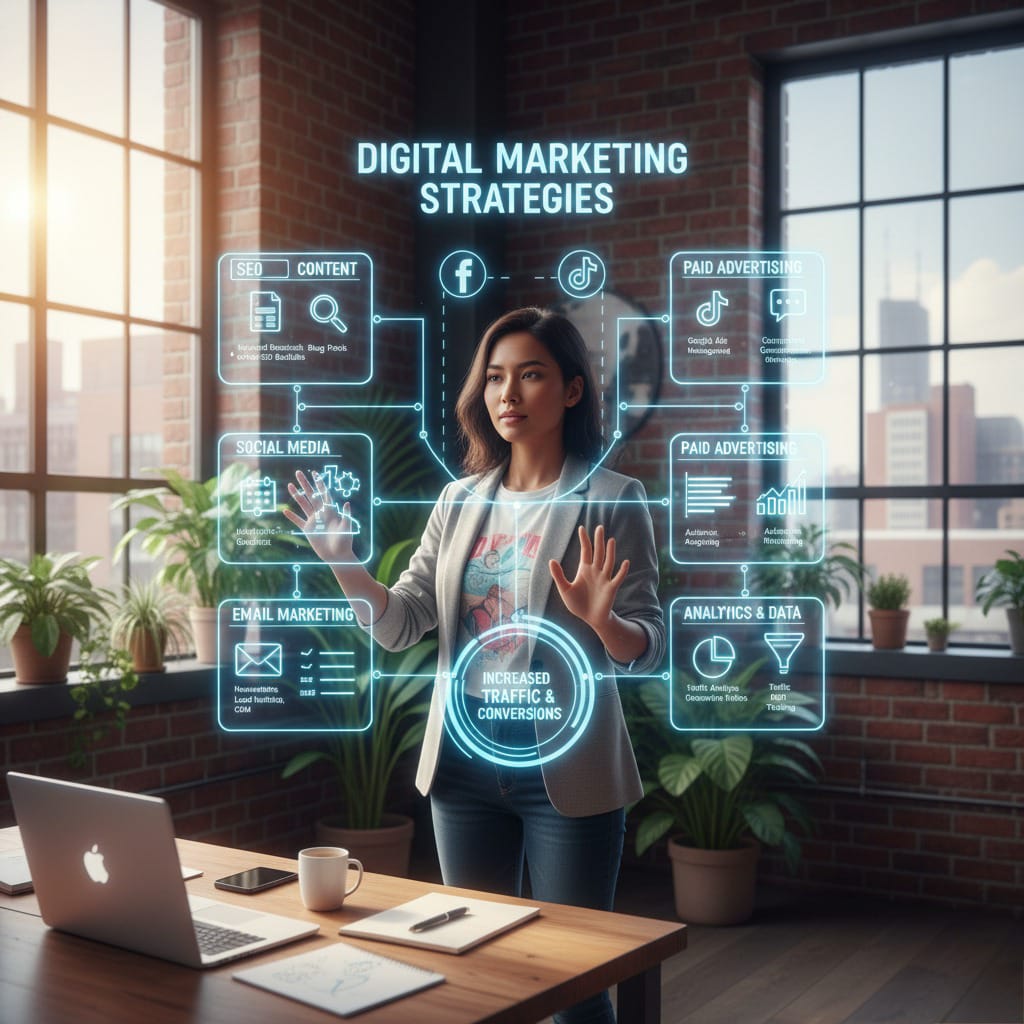Digital marketing is evolving at an unprecedented pace, and businesses worldwide need to adapt quickly to remain competitive. In 2025, leveraging SEO, social media marketing, paid ads, and content marketing strategically will be essential to reach target audiences, drive conversions, and grow brand visibility. This comprehensive guide covers advanced strategies, tools, and actionable steps to create an effective digital marketing plan for 2025.

Master SEO, Social Media, Paid Ads & Content Marketing in 2025
1. The Evolution of Digital Marketing
Digital marketing has transformed from basic website promotion to a multi-channel ecosystem involving search engines, social media platforms, email campaigns, influencer marketing, and AI-powered automation. In 2025, marketers need to focus on personalization, user experience, data-driven decision-making, and omnichannel presence to succeed.
2. SEO Strategies for 2025
Search Engine Optimization (SEO) remains the backbone of digital marketing. Google's algorithms continue to evolve, emphasizing user intent, content quality, and technical SEO. Here's how to stay ahead:
2.1 On-Page SEO
- Use focus keywords naturally in titles, meta descriptions, headings, and first 100 words.
- Optimize URL structure with relevant keywords (e.g., /digital-marketing-strategies-2025).
- Implement internal linking to improve navigation and distribute page authority.
- Use schema markup for rich snippets and FAQs.
- Ensure mobile-friendly design and fast page load speed (under 2 seconds).
2.2 Off-Page SEO
- Build high-quality backlinks from authoritative websites.
- Engage in guest posting and PR campaigns to increase domain authority.
- Use social signals from shares, mentions, and engagement to enhance credibility.
- Participate in relevant forums and communities to establish thought leadership.
2.3 Technical SEO
- Implement structured data (JSON-LD) for products, articles, and events.
- Fix crawl errors using Google Search Console.
- Use SSL certificates and HTTPS for secure browsing.
- Optimize images with alt attributes and compress file sizes.
- Improve website architecture for better indexing.
3. Social Media Marketing in 2025
Social media remains a powerful channel to engage audiences and build brand authority. In 2025, platforms like Instagram, TikTok, LinkedIn, YouTube, and emerging AI-driven social apps will dominate.
3.1 Content Strategy
- Create platform-specific content (e.g., short-form videos for TikTok/Reels, carousel posts for LinkedIn).
- Leverage storytelling to increase engagement and shares.
- Use user-generated content and influencer partnerships for credibility.
- Maintain consistent branding and posting frequency.
3.2 Paid Social Ads
- Target audiences based on demographics, interests, behaviors, and lookalike segments.
- Use retargeting ads to convert website visitors into leads or customers.
- Monitor ad performance using A/B testing and analytics tools.
- Focus on ROAS (Return on Ad Spend) rather than just impressions.
3.3 Engagement & Community Building
- Respond to comments, messages, and reviews promptly.
- Host live sessions, webinars, and Q&A to increase interaction.
- Build niche communities for loyal brand followers.
- Use polls, quizzes, and challenges to boost engagement.
4. Paid Ads Strategy for 2025
Paid advertising allows precise targeting and fast results. In 2025, combining search ads, display ads, social media ads, and programmatic advertising will drive ROI.
4.1 Search Engine Ads (Google Ads)
- Target high-intent keywords for better conversion.
- Use ad extensions like sitelinks, callouts, and structured snippets.
- Monitor Quality Score to reduce CPC and improve ad performance.
- Use retargeting campaigns for abandoned cart or website visitors.
4.2 Social Media Paid Campaigns
- Run A/B tests for creatives, copy, and call-to-actions.
- Optimize campaigns for conversions rather than clicks.
- Use influencer partnerships to boost paid campaign reach.
- Monitor audience feedback and adjust targeting.
4.3 Programmatic & Display Ads
- Leverage AI-driven bidding strategies for optimal cost-per-acquisition.
- Target niche audiences based on behavior, location, and interest.
- Use dynamic creatives for personalized ad experiences.
- Analyze ad viewability and engagement metrics regularly.
5. Content Marketing Strategies
Content marketing continues to be a vital pillar of digital marketing. High-quality, engaging content builds trust, authority, and long-term relationships.
5.1 Blogging & SEO Content
- Create long-form, evergreen content targeting high-volume keywords.
- Use on-page SEO: headings, internal linking, schema, alt text.
- Focus on readability and user experience.
- Repurpose blog content into videos, infographics, and social posts.
5.2 Video Marketing
- Leverage YouTube, Instagram Reels, TikTok, and LinkedIn videos.
- Create how-to tutorials, product demos, testimonials, and stories.
- Optimize video titles, descriptions, and tags for SEO.
- Engage viewers with captions, CTAs, and playlists.
5.3 Email & Automation
- Segment audiences for personalized campaigns.
- Use drip campaigns to nurture leads.
- Integrate AI tools for predictive personalization and content suggestions.
- Track open rates, CTR, conversions, and revenue attribution.
6. Analytics & Measurement
Data-driven marketing ensures strategies are effective. Track KPIs, measure ROI, and optimize campaigns:
- Google Analytics 4 for web traffic and behavior insights.
- Social media analytics for engagement, reach, and audience demographics.
- Conversion tracking for paid ads.
- A/B testing for landing pages, emails, and creatives.
- Monthly performance reports to adjust marketing strategies.
7. Emerging Trends in 2025
- AI-generated content and chatbots for engagement.
- Voice search optimization for smart devices.
- Interactive content like polls, AR/VR, and gamified experiences.
- Micro-influencer marketing for niche audience targeting.
- Sustainability-focused marketing for conscious consumers.
Conclusion
Digital marketing in 2025 is about personalization, omnichannel presence, and data-driven strategies. Businesses that combine SEO, social media, paid ads, and content marketing effectively will dominate their niche. Constant monitoring, analytics, and adaptation to emerging trends are essential to stay ahead in the competitive digital landscape.
🎯 Key Takeaways
- Focus on user intent and quality content for SEO success.
- Leverage social media with engaging content and paid campaigns.
- Use paid ads strategically with retargeting and A/B testing.
- Content marketing remains essential for authority and engagement.
- Analytics and KPIs help optimize campaigns and improve ROI.
- AI, interactive content, and sustainability trends shape 2025 marketing.